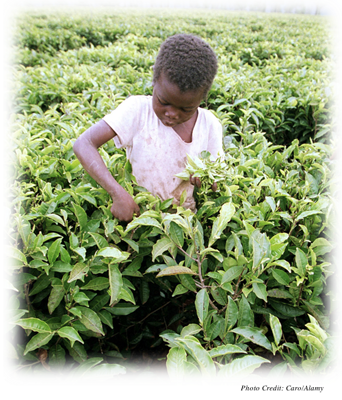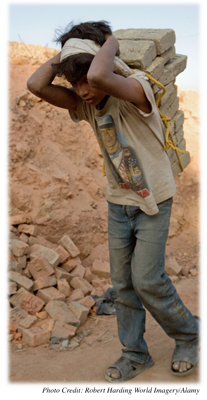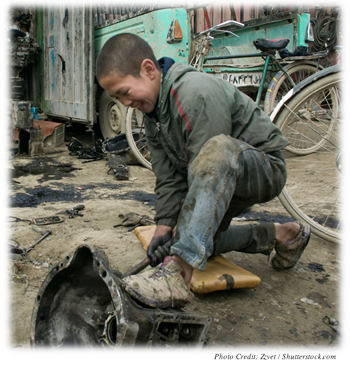Stolen Childhoods
Slide 1 of 14: Synopsis

Author
Pauline Davey Zeece, University of Nebraska – Lincoln
Synopsis
This activity investigates the abuse, maltreatment, and neglect of child workers across the globe while featuring the child laborers of Nepal – from those in carpet mills and the sex trade to those who make their livelihood on the streets. With the help of video, the impact of these situations and conditions on developing young children will be seen and heard as child workers tell the stories of their stolen childhoods.
References
Bellamy, C. (Ed.), (1997). State of the Worlds Children, 1997. Oxford, ENG: Oxford University Press.
Ford Foundation. (2001). Children of the Looms: Rescuing the Children of Nepal, India, and Pakistan. Retrieved May 20, 2007, from http://www.colorado.edu/journals/cye/13_2/FieldReports/ChildrenoftheLooms/ChildrenoftheLooms.htm
Global Fund for Children. (2002). Hazardous and Harmful Child Labor. Retrieved May 20, 2007, from: http://www.globalfundforchildren.org/pdfs/gfc_harmful_labor.pdf
GoodWeave. http://www.goodweave.org
ILO/IPEC. (2003). International Programme on the Elimination of Child Labour. Facts about Child Labour. Retrieved May 20, 2007, from: http://www.ilo.org/public/english/tstandards/ipec/publ/download/factsheets /fs_ipecstrategy_0303.pdf
Independent Media Center. (2002). Disney’s Wonderful World of Sweatshops. Retrieved May 20, 2007, from: http://indy.pabn.org/archives/105disne.shtml
LaFranier, S. (2 November, 2006). Africa’s World of Forced Labor, in a 6-Year-Old’s Eyes. New York Times. Retrieved May 21, 2007, from: http://nytimes.com/2006/10/29/world/africa/29ghana.html
UNICEF. (2007). Child Protection from Violence, Exploitation, and Abuse: Retrieved May 20, 2007, from: http://www.unicef.org/protection/index_childlabour.html
United States Department of Labor. (2007). Nepal. Retrieved on May 17, 2007, from: http://www.dol.gov/ilab/media/reports/iclp/sweat/nepal.htm
Slide 2 of 14: The World's Youngest Workers

Have you ever seen a beaming child proudly display a colorful logo-embroidered t-shirt as a prize from a recent family trip? There is a good chance that the shirt was sewn by child laborers who will never be able to afford such fun trips, new clothes, or vacation souvenirs (Independent Media Center, 2002).
Every year, the trafficking and labor of children produces $10 billion worth of trade. It is endemic in desperately poor areas of the world. In countries where parents cannot afford to feed their families, selling a child’s labor to someone who can teach a trade and possibly send the child to school seems more reasonable than keeping children at home to starve. In other instances, children are orphaned or lured from desperate situations by the promise of opportunities and education in faraway cities.
Often these promises are merely a marketing tool. Instead, children are crushed by the futility of their situation and the danger of their tasks. They find themselves far from home and often beaten or frightened into submission (LaFranier, 2006).
Slide 3 of 14: The Jobs Children Do
- Chapters
- descriptions off, selected
- captions settings, opens captions settings dialog
- captions off, selected
- English Captions
This is a modal window.
Beginning of dialog window. Escape will cancel and close the window.
End of dialog window.
This is a modal window. This modal can be closed by pressing the Escape key or activating the close button.
This is a modal window.
Nearly 211 million children between the ages of 5 and 14 are part of the worldwide work force and are engaged in work that falls under the international definitions of child labor (International Labor Organization, 2000). UNICEF counts seven main types of child labor, including domestic service, forced and bonded labor, commercial sexual exploitation, industrial or plantation labor, street work, and work for the family (Bellamy, 1997; Global Fund for Children, 2002). Much of this work, according to standards set in 1999 by the International Labor Organization (ILO), is “harmful or hazardous to health, safety, or morals of girls and boys under 18 years of age” (ILO/IPEC, 2003).
Play the video to see children from Albania, the Philippines, and Nicaragua (in that order) — all of whom have been exploited in the workforce and in the sex trade.
Slide 4 of 14: The Numbers Tell the Story

Nearly two-thirds of child workers — an estimated 171 million children or one in eight children ages 5 to 14 — labor in hazardous or harmful jobs, such as working in mines, with chemicals and pesticides in agriculture, or with dangerous machinery (Global Fund for Children, 2002). Millions of girls who work as domestic servants are especially vulnerable to exploitation and abuse. An estimated 1.2 million children are trafficked; 5.7 million are forced into debt bondage or other forms of slavery; 1.8 million are lured into prostitution and pornography; 0.3 million end up participating in armed conflict; 0.6 are involved in other illicit activities. However, the vast majority of child laborers —70% or more — work in agriculture. These young workers are everywhere but largely out of the world’s eye or consciousness (UNICEF, 2007).
Slide 5 of 14: No Place for Play
- Chapters
- descriptions off, selected
- captions settings, opens captions settings dialog
- captions off, selected
- English Captions
This is a modal window.
Beginning of dialog window. Escape will cancel and close the window.
End of dialog window.
This is a modal window. This modal can be closed by pressing the Escape key or activating the close button.
This is a modal window.
Child labor robs many children of their childhoods, and it impedes their development. All developmentalists agree that children need families. In the ideal world, the family function is to meet the needs of children by providing them with food, clothing, and shelter while encouraging them to learn, nurturing their developmentally appropriate interactions with others, and providing harmony and stability at home. For most families of child workers, the world is not ideal, and family function falls short of meeting children’s developmental needs.
Play the video to listen to two Nepalese children describe their lives as laborers in a carpet factory.
Slide 6 of 14: Developmental Needs of Child Workers

Psychologist Erik Erikson described the physical, emotional, and psychological stages of development along with related specific issues, or developmental work, for each stage.
By the age of five, which is the point at which statistics on child workers are first collected, most children enter into the initiative versus guilt stage. Children who master the crises of this stage exhibit initiative. This helps them to respond positively to the world’s challenges, learn new skills, and feel purposeful. Initiative is best achieved through play. Yet, for many child laborers, there is little time for childhood play in the adult world of work. Failure to meet the challenges of this stage may result in inhibition wherein striving and trying, and even dreaming of a better future, disappears.
Slide 7 of 14: Developmental Needs of Child Workers (continued)

Slide 8 of 14: Child Labor and Maltreatment
- Chapters
- descriptions off, selected
- captions settings, opens captions settings dialog
- captions off, selected
- English Captions
This is a modal window.
Beginning of dialog window. Escape will cancel and close the window.
End of dialog window.
This is a modal window. This modal can be closed by pressing the Escape key or activating the close button.
This is a modal window.
Child labor represents the largest single cause across the globe of child maltreatment. Many child workers experience child neglect because they are denied basic health care, adequate nutrition, and education. Additionally, other children suffer physical and sexual abuse at the hands of their employers and, at times, even by their own families.
Play the video to hear Chhakali, a young rescued Nepalese girl, tell her story of betrayal and loss.
Slide 9 of 14: Child Labor and Maltreatment (continued)
- Chapters
- descriptions off, selected
- captions settings, opens captions settings dialog
- captions off, selected
- English Captions
This is a modal window.
Beginning of dialog window. Escape will cancel and close the window.
End of dialog window.
This is a modal window. This modal can be closed by pressing the Escape key or activating the close button.
This is a modal window.
Play more of the interview with Chhakali to find out what became of her after being rescued by the police during a raid on the brothel.
Slide 10 of 14: Reaching Out — Making a Difference
- Chapters
- descriptions off, selected
- captions settings, opens captions settings dialog
- captions off, selected
- English Captions
This is a modal window.
Beginning of dialog window. Escape will cancel and close the window.
End of dialog window.
This is a modal window. This modal can be closed by pressing the Escape key or activating the close button.
This is a modal window.
Several governmental and industry-supported programs have stepped in to help combat Nepal’s child labor crisis. One of these is GoodWeave (formerly known as RugMark). GoodWeave is an organization of carpet manufacturers and exporters in Nepal, India, and Afghanistan that works with European and North American importers and businesses to help secure markets for their products that are not produced by child labor.
Through a system of labels, each rug produced can be traced to a specific factory and loom, which are regularly inspected. When inspectors find children working on these looms, the employers are fined. The formerly employed children are sent to local schools close to their families or placed in one of many GoodWeave-sponsored rehabilitation centers or schools depending on the needs of the individual child. These efforts help reduce the number of child workers and give children a chance to be educated (http://www.GoodWeave.org).
Play the video to learn how GoodWeave (formerly RugMark) has changed the lives of child workers.
Slide 11 of 14: Assessment: Check Your Understanding
- Chapters
- descriptions off, selected
- captions settings, opens captions settings dialog
- captions off, selected
- English Captions
This is a modal window.
Beginning of dialog window. Escape will cancel and close the window.
End of dialog window.
This is a modal window. This modal can be closed by pressing the Escape key or activating the close button.
This is a modal window.
Slide 12 of 14: Assessment: Check Your Understanding

Slide 13 of 14: Assessment: Check Your Understanding

Slide 14 of 14: Assessment: Check Your Understanding
- Chapters
- descriptions off, selected
- captions settings, opens captions settings dialog
- captions off, selected
- English Captions
This is a modal window.
Beginning of dialog window. Escape will cancel and close the window.
End of dialog window.
This is a modal window. This modal can be closed by pressing the Escape key or activating the close button.
This is a modal window.
Congratulations! You have completed this activity.Total Score: x out of x points (x%) You have received a provisional score for your essay answers, which have been submitted to your instructor.